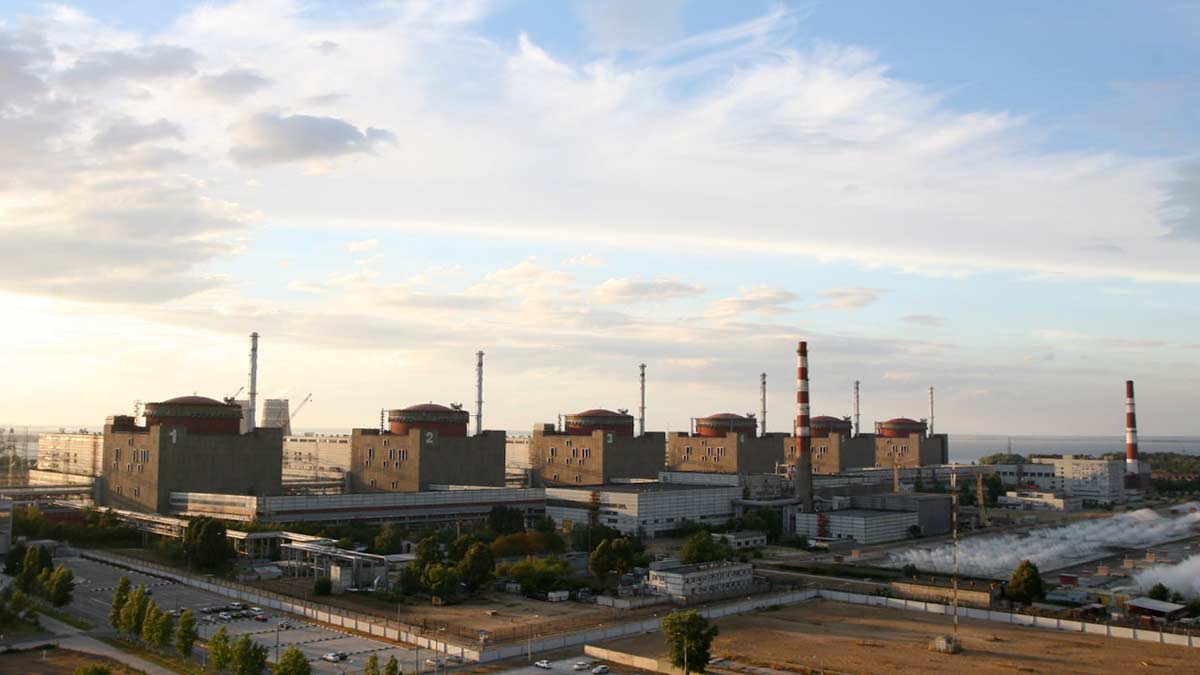Breaking News
Zaporizhzhia Nuclear Power Plant is falling apart, and the world is ignoring the danger
Leaks, power outages, low staffing, and no maintenance plan. Europe’s largest nuke plant is falling apart.

[WBHG 24 News] – The latest reports from the International Atomic Energy Agency (IAEA), which has had a team of international inspectors at the Zaporizhzhia Nuclear Power Plant for 16 months, painted an alarming picture of leaking steam generation circuits and safety systems, inadequate staff, and no 2024 maintenance plan.
Europe’s largest nuclear power plant is located in occupied Enerhodar. Previously located on the banks of the Kakhovka Reservoir, the primary source of cooling water for ZNPP drained away in June 2023 after the Kakhovka Dam was destroyed. Russian forces captured the plant on March 3, 2022, during the opening days of the expanded war of aggression against Ukraine. Webcams showed Russian tanks firing on the power plant and shooting into administrative buildings during the brief siege.
After pictures, videos, and satellite images proved that Russian forces had militarized the plant in violation of international humanitarian law and the pillars of nuclear safety, the IAEA, backed by the United Nations, pressured Russia to establish an international group of permanent monitors. On September 1, IAEA Director General Rafael Grossi and a team of experts, accompanied by Russian state media, arrived at the plant. There have been 15 rotations of monitors since.
Three reactors have various leaks, and Russia doesn’t plan to fix them
Currently, five of the six reactors at ZNPP are in cold shutdown, with Reactor 4 in hot shutdown to provide steam for plant operations and heat for the nearby town of Enerhodar.
On November 17, IAEA inspectors were told by Russian occupiers that boron had been detected in the secondary cooling circuit of Reactor 4, which was in hot shutdown at the time. Boron is added to the primary cooling and steam circuits of modern nuclear reactors as an extra safety measure. Boron isn’t supposed to be the secondary cooling system, but trace amounts are acceptable.
Four days later, the reactor was shut down, with Russia declaring the boron leak was within acceptable levels and would not be repaired. This was the second unscheduled shutdown of 2023. On August 10, Reactor 4 had to be shut down after a water leak was discovered in one of its steam generators. Plant technicians also found that the heat exchangers needed to be cleaned and did regular maintenance on the reactor’s transformers and emergency diesel generators.
On December 22, inspectors found boric acid deposits on valves, a pump, and on the floors of several rooms in the containment building of Reactor 6. Russian occupation officials said the leak was coming from a cracked boric acid storage tank and it would not be repaired. After IAEA Director-General Rafael Grossi published the finding in a January 3 update, inspectors were barred from accessing parts of Reactor 6 for almost two weeks.
On February 1, the IAEA reported that boric acid leaks were also discovered in Reactor 1.
Unreliable external power connections
Although power plants generate electricity, power to run a power plant is provided by external sources. This provides a layer of safety by assuring that there is always electricity to support normal operations in the event of a facility shutdown. Although a nuclear reactor can be “shut down,” it still needs external power to continuously circulate cooling water in the reactors and on-site spent fuel storage. In the event of a total power failure, backup generators running on diesel fuel become the last line of defense. ZNPP has 20 generators and keeps enough diesel for a minimum of ten days of operation.
It’s estimated that if a ZNPP reactor is in cold shutdown, it can go more than three weeks without water circulation. But in hot shutdown, a meltdown can start 27 hours after the loss of all external power. In the worst-case scenario, the absolute last line of defense is when a nuclear plant operates in “island mode.” That’s when a reactor or reactors are used to generate onsite power to maintain plant operations. It’s inherently dangerous because it requires bringing a reactor online, leaving no margin for error if there are any additional failures. None of ZNPP’s reactors have produced electricity in the last 18 months.
Before Russia’s hostile takeover, ZNPP had ten redundant external power connections – four 750 kilovolt (kV) and six more 330 kV lines from the nearby Zaporizhzhia Thermal Power Plant (ZTPP), which Russia also occupies. Today, the plant only has two. Since the occupation, Europe’s largest nuclear power plant has lost all external power eight times, forced to rely on onsite diesel-powered emergency generators. But the problems don’t stop there.
On March 1, 2023, Russian shelling of the Nikopol Raion on the right bank of the Dnipro River damaged infrastructure that cut the 330 kV external power connection to ZNPP. Ukrainian officials told the IAEA that due to unrelenting Russian attacks on the area, it was impossible for technicians to repair the damage. The plant was now reliant on a single 750 kV power connection while Russia was attacking Ukraine’s energy infrastructure.
Power had come from the nearby ZTPP in the past, but Russian officials claimed that the switchyard between the two power plants was damaged. The IAEA repeatedly asked to inspect the area, with Russian operators denying access, promising that repairs were imminent.
Three months later, Grossi said, “Our experts must access the ZTPP to see for themselves what the current situation is like and whether it might be possible to restore backup power there.”
On June 11, he repeated his request to allow the on-site inspection team to visit the switchyard, and five days later, Grossi joined the IAEA staff during its rotation. The Russians permitted him to inspect the damage, and the connection was restored on July 1. However, there was a misconfiguration in the repairs. When power was cut to the 750 kV line, the 330 kV backup didn’t automatically roll over. The plant had to use onsite diesel generators while technicians solved the problem.
On November 15, Reactor 6 unexpectedly lost all power for 90 minutes, briefly shutting down the cooling circuits before it was switched to emergency power. The reason for the failure was not published.
On November 26, power was lost from the single 750 kV external connection due to a historically powerful storm that moved across the Black Sea. While power successfully rolled over to the backup 330 KV line, Reactor 4 didn’t energize, forcing plant operators to use the emergency onsite diesel generators. During the August 2022 unscheduled maintenance, the backup systems were also misconfigured.
The most recent incident was on December 2, when both external power lines failed. The 330 kV connection failed first due to an “external grid fault.” Five hours later, the 750 kV connection also disconnected. During the outage, power was lost to all four cooling pumps for Reactor 4, forcing operators to start moving it to cold shutdown, which could have left the plant with an inadequate supply of steam. Diesel generators were brought online, restoring power, and the 750 kV line was reconnected five hours later.
Blocked access, broken promises, and landmines
To successfully complete its role as a nuclear watchdog, IAEA inspectors need unfettered access to ZNPP. Russia has repeatedly hampered these efforts.
When high-resolution satellite images showed that Russian forces had built small arms gun emplacements on the roof of the reactors, the IAEA requested access to verify there were no violations of the pillars of nuclear safety and international humanitarian law. Russian occupiers stonewalled the IAEA for months, finally granting access to the roofs of Reactors 2, 3, and 4. Inspectors were supposed to be allowed on the other three units on December 19, but the inspection was canceled at the last minute due to “security reasons.”
Inspectors have also been blocked from consecutively walking through the six-turbine halls and maintenance areas. When the IAEA arrived at ZNPP on September 1, 2022, military vehicles were found in some of the maintenance areas, but there weren’t any offensive weapons or ammunition. A continuous walk-through would permit the IAEA to confirm that heavy weapons or ammunition are not stored in any of the turbine halls and that Russian occupiers aren’t playing a shell game. Despite repeated requests during individual inspections, the IAEA has not been allowed into all areas of the turbine halls since 2022.
Russia placed land and directional mines in restricted areas and on the perimeter of the plant after the occupation. Grossi stated that their presence violated the principles of nuclear safety but added none of the explosives were located in critical areas of the plant. In November, with Russia’s fall-winter offensive in full swing, the mines were removed, only to be replaced in late January.
Starting in December, Russian occupiers have blocked the IAEA from asking new workers at ZNPP about their training and credentials. Additionally, despite repeated requests, Russian operator Rosatom has refused to provide a comprehensive site maintenance plan for 2024.
Russian occupiers also disconnected the online radiation monitoring systems, forcing the IAEA team to take manual readings twice a day using a backpack system. The background radiation information is handed off to Russia, which shares the data twice a day.
A worsening staffing crisis
In January 2022, ZNPP had 11,500 employees, with most living in the nearby town of Enerhodar. While some fled at the start of Russia’s war of aggression, many stayed behind due to their sense of duty to nuclear safety. Since the Russian occupation, Ukrainian workers and their families have been interrogated, kidnapped, and tortured. Some have disappeared. In Enerhodar, residents living under occupation have reported extrajudicial arrests, disappearances, robberies, and evictions, mostly at the hands of Chechen forces.
After the illegal annexation of the Zaporizhzhia Oblast in October 2022, the Ukrainian staff working for Energoatom who had not aligned themselves with Russia were subjected to forced passportization and constant coercion to sign employment contracts with Rosatom. Some gave in, others fled, while others resisted. On January 25, in a report to the United Nations Security Council, Grossi said, “operating on significantly reduced staff, who are under unprecedented psychological pressure – which despite the reactors being shutdown is not sustainable.”
On February 1, the IAEA was notified that all remaining employees of ZNPP who had not accepted Russian citizenship and were still employees of Energoatom were barred from the plant. Russian occupiers told the onsite inspectors, “There are enough certified personnel at the plant, and all positions are fully filled.”
According to the IAEA, the plant is staffed at just 39% of its pre-occupation level, with 4,500 workers and 940 job applications under review. Russian occupiers closed the so-called “road of life” between Vasyivka and Kamyanske in December 2022 and never reopened it. For Energoatom employees and their families who are now jobless and want to leave the occupied territories, it will require a journey through Russia, where they risk filtration, interrogation, and arrest.
How dangerous is the situation
After briefing the U.N. Security Council last month, Grossi held a brief press conference.
When asked on a scale of one to ten, “ten being the most dangerous and one being secure,” what would you rank Zaporizhzhia [NPP] right now, he said, “Well, as I was telling…her just a minute ago, I think there are days where you are near ten, and there are days that nothing seems to happen – and the problem is this. The complete uncertainty because this is a war.”
Grossi was also asked about the level of cooperation Ukraine and Russia were providing to the IAEA, telling reporters, “Yes. I would say, by and large, yes. Of course, there are – there are moments of frustration. Mine and theirs, I guess, because sometimes when I say things that they don’t appreciate, or that I or they would prefer me to say differently – there is tension – there but – this is a little bit – what the – is all about. And this happens to us when it comes to Iran. When it comes to the DPRK. People sometimes do not appreciate what we have to say, but we have to say it anyway.”
In June 2023, when the world had its eyes on ZNPP, nuclear experts told us it would be extremely difficult for there to be a Fukushima or Chornobyl-sized accident or a European continent-obliterating act of nuclear terrorism. ZNPP has Pressure Water Reactors, which are very similar to Western nuclear power plants and have little in common with the infamous Soviet-era RBMK reactors. The vessels for all six reactors were designed to survive the impact of a commercial airliner crashing into them. In a cold shutdown state, it would take weeks for the reactors to start to melt down, which would require the removal or arrest of the onsite IAEA inspectors and weeks of denials and cover-ups.
Scenario one – radioactive water or steam release
This was considered the second most likely accident or act of intentional sabotage. A release of radioactive steam or water would contaminate a limited area with mild to moderate levels of radiation. With the Kakhovka Reservoir drained away, the threat to the water supply is not as dire as it was at the start of 2023. This would also be the easiest accident to clean up.
Scenario two – breach or loss of coolant to spent fuel storage
ZNPP has onsite storage for spent nuclear fuel, which requires cooling and containment. In a worst-case scenario, the intentional destruction of containment would have a similar impact to a dirty bomb, spreading highly radioactive material over a relatively small area. Irradiated material would be carried by the wind, spreading mild to moderate radioactive over a larger area. Clean-up would be complex and expensive, and a small area, when compared to the two most infamous accidents of the nuclear age, could be left uninhabitable. If the spent fuel storage lost circulation or its coolant, the materials would heat up, eventually burning through their containment.
Scenario three – meltdown
While ZNPP doesn’t have all of the safety systems of its Western peers, the facility is well-engineered with the reactors encased in a protective vessel, the concrete and steel reinforced external containment building, redundant cooling systems, fire suppression systems, boron injection systems, and multiple backups. An accidental full meltdown is always theoretically possible but nearly impossible. Even in the event of a full meltdown of one or all the reactors, it would take an intentional act to breach the outer containment vessels. In the worst-case scenario, radiation would impact all of Ukraine, parts of Russia, and many areas of eastern and central Europe. However, claims that the plant would explode like 20 megaton hydrogen bombs are inaccurate.
Scenario four – economic terrorism
Faced with having to withdraw from ZNPP, experts told us the most likely scenario would be Russian occupiers intentionally contaminating the reactor vessels, rendering the plant unusable. While the radiation risk outside of the plant would be low, releasing large amounts of radiation in one, some, or all of the containment buildings would block access. It would also make attempts to repair ZNPP not only complex and dangerous but potentially economically unviable.
A very uncertain future
Director General Grossi is traveling to Kyiv on February 6 and will visit ZNPP for the fourth time the next day during the 16th rotation of the IAEA inspectors. After his visit, he plans to travel to Moscow for additional meetings with Russian officials.
The approach to maintenance, training, and staffing that Russian enterprise Rosatom is taking at ZNPP provides a glimpse into how Moscow runs its other nuclear facilities. With the world’s attention focused on the Middle East, there’s a ticking timebomb in the middle of Ukraine, and not enough people are paying attention.








